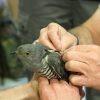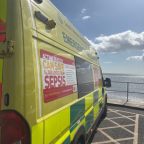
Spring is in the air and so are Dartmoor’s cuckoos!
The Dartmoor cuckoo project, which began with the tagging of seven Dartmoor birds in 2013 and 2014, is waiting and hoping that the two birds – called Whortle and Emsworthy, who survived the arduous migration to Africa will make it back to our shores this spring.
Dartmoor National Park (DNP), in partnership with Devon Birds, is taking part in the ground-breaking national satellite tagging project run by the British Trust for Ornithology (BTO) to learn about the migration of Dartmoor’s cuckoos and start to understand the reasons for their alarming decline.
In May 2013, satellite tags were put onto four Dartmoor cuckoos, with a further three birds tagged in May 2014. Sadly, the fate of five of these seven birds mirrors the national picture of decline, with a 70% decrease in the population witnessed in the last 20 years: Only two of the seven birds were still sending signals from their wintering grounds in Africa earlier this year, and it is feared that one of these two birds might have perished now as well, leaving us with just one active tagged cuckoo. We hope both cuckoos still survive and will arrive back on our shores in late April. You can follow their routes by following the links on www.dartmoor.gov.uk/cuckoo
In a further effort to understand what is causing these drastic declines, Devon Birds have created a live web map that allows members of the public to enter their cuckoo sightings. This interactive map was launched last year with a plea for records from the public – and we received an amazing 700 records!
George Harris, chairman of Devon Birds, said: Despite the cuckoo being such an iconic bird, little is known about their numbers, distribution and behaviour here on Dartmoor. Asking the public to report their sightings last year was very successful. Our interactive map is up and running again this year and we ask the public to enter their records via our website www.devonbirds.org/cuckoos or telephone 01822 853785. We are hoping to gather more information about cuckoos, especially in the more remote parts of Dartmoor and outside the National Park area.
Naomi Barker, DNP Ecologist, said: We are working with a team at Exeter University to build a picture of how cuckoos use the Dartmoor countryside – where they eat, where they nest, where they mate, and so on - so that we can start to understand what might be missing and be part of the cause of this worrying decline. Once we know that, we can plan new ways to prevent this iconic bird disappearing from our spring chorus.
You can report your cuckoo sightings by going to www.devonbirds.org/cuckoos or calling in to any Dartmoor National Park Visitor Centre. You can follow active cuckoos Emsworthy and Whortle on their journey by going to www.dartmoor.gov.uk/cuckoo, www.devonbirds.org/cuckoos or www.bto.org/cuckoos.

















